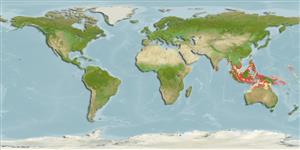>
Eupercaria/misc (Various families in series Eupercaria) >
Haemulidae (Grunts) > Plectorhinchinae
Etymology: Diagramma: Greek, diagramma = mark out by lines (Ref. 45335); melanacrum: From the Greek melanos meaning black, and akros meaning tip or at the end - in reference to the black outer part of anal and pelvic fins and lower part of caudal fin (Ref. 44143).
More on authors: Johnson & Randall.
Environment: milieu / climate zone / depth range / distribution range
Ecologia
marino benthopelagico; distribuzione batimetrica 3 - 40 m (Ref. 90102). Tropical
Indo-West Pacific: Indonesia, Borneo and the Philippines. Also reported from Australia, Timor Sea (Ashmore Reef) and Myanmar.
Size / Peso / Age
Maturity: Lm ? range ? - ? cm
Max length : 45.0 cm SL maschio/sesso non determinato; (Ref. 48635)
Short description
Chiavi di identificazione | Morfologia | Morfometria
Spine dorsali (totale) : 10 - 11; Raggi dorsali molli (totale) : 22 - 24; Spine anali: 3; Raggi anali molli: 6 - 7. Tubed lateral line scales 55-57; outer row of teeth in jaws slightly enlarged, movable; swim bladder with 3 short anterior projections; third or fourth dorsal spine longest, 1.8-1.9 in head; first dorsal spine 1.7-2.3 in length of second; interspinous membrane of dorsal fin not incised; pelvic fins reaching vent or slightly beyond, 1.2-1.3 in head; body light yellow dorsally, shading to pale silvery grey on sides and ventrally, with numerous small dark brown spots, which are smaller and form oblique rows on body below lateral line; head light purplish grey with numerous small dark brown spots, opercular membrane black; dorsal fin and upper 3/4 of caudal fin with small dark spots; lower 1/4 of caudal fin black; anal and pelvic fins mainly black (Ref. 44143); dorsal and caudal fins mainly yellow, caudal fin with broad black lower edge margin, caudal fin may be slightly emarginate to truncate; body depth 2.4-2.6 in SL (Ref. 90102). Juveniles from 13.3 cm SL with spots about size of pupil on head, body, dorsal and caudal fins becoming progressively smaller and more numerous with age; juveniles and subadults up to 25.4 cm SL with narrow discontinuous wavy lines on operculum and cheeks, extending to about level of anterior margin of eye (with lines breaking up into spots in larger specimens) (Ref. 44143). Large juveniles have spots in longitudinal rows and also solid stripes (Ref. 90102).
Juveniles in estuaries and silty reefs on open substrates with remote outcrops or reef or debris. Adults on deep reefs along walls with large caves. Often in small aggregations in depths of 30 m or more (Ref. 48635).
Life cycle and mating behavior
Maturità | Riproduzione | Deposizione | Uova | Fecundity | Larve
Distinct pairing during breeding (Ref. 205).
Johnson, J.W., J.E. Randall and S.F. Chenoweth, 2001. Diagramma melanacrum new species of haemulid fish from Indonesia, Borneo and the Philippines with a generic review. Mem. Queensl. Mus. 46(2):657-676. (Ref. 44143)
IUCN Red List Status (Ref. 130435: Version 2024-2)
Threat to humans
Harmless
Human uses
Strumenti
Special reports
Download XML
Fonti Internet
Estimates based on models
Preferred temperature (Ref.
123201): 27.9 - 29, mean 28.5 °C (based on 150 cells).
Phylogenetic diversity index (Ref.
82804): PD
50 = 0.5312 [Uniqueness, from 0.5 = low to 2.0 = high].
Bayesian length-weight: a=0.01820 (0.01078 - 0.03072), b=3.06 (2.91 - 3.21), in cm total length, based on LWR estimates for this species & (Sub)family-body (Ref.
93245).
Trophic level (Ref.
69278): 3.7 ±0.5 se; based on size and trophs of closest relatives
Resilienza (Ref.
120179): Medio, tempo minimo di raddoppiamento della popolazione 1.4 - 4.4 anni (Preliminary K or Fecundity.).
Fishing Vulnerability (Ref.
59153): Moderate vulnerability (42 of 100).
Nutrients (Ref.
124155): Calcium = 61.8 [31.2, 245.8] mg/100g; Iron = 0.723 [0.300, 2.008] mg/100g; Protein = 18.2 [15.9, 20.4] %; Omega3 = 0.165 [0.072, 0.384] g/100g; Selenium = 45 [16, 152] μg/100g; VitaminA = 35.4 [12.8, 95.1] μg/100g; Zinc = 0.723 [0.381, 1.831] mg/100g (wet weight);
